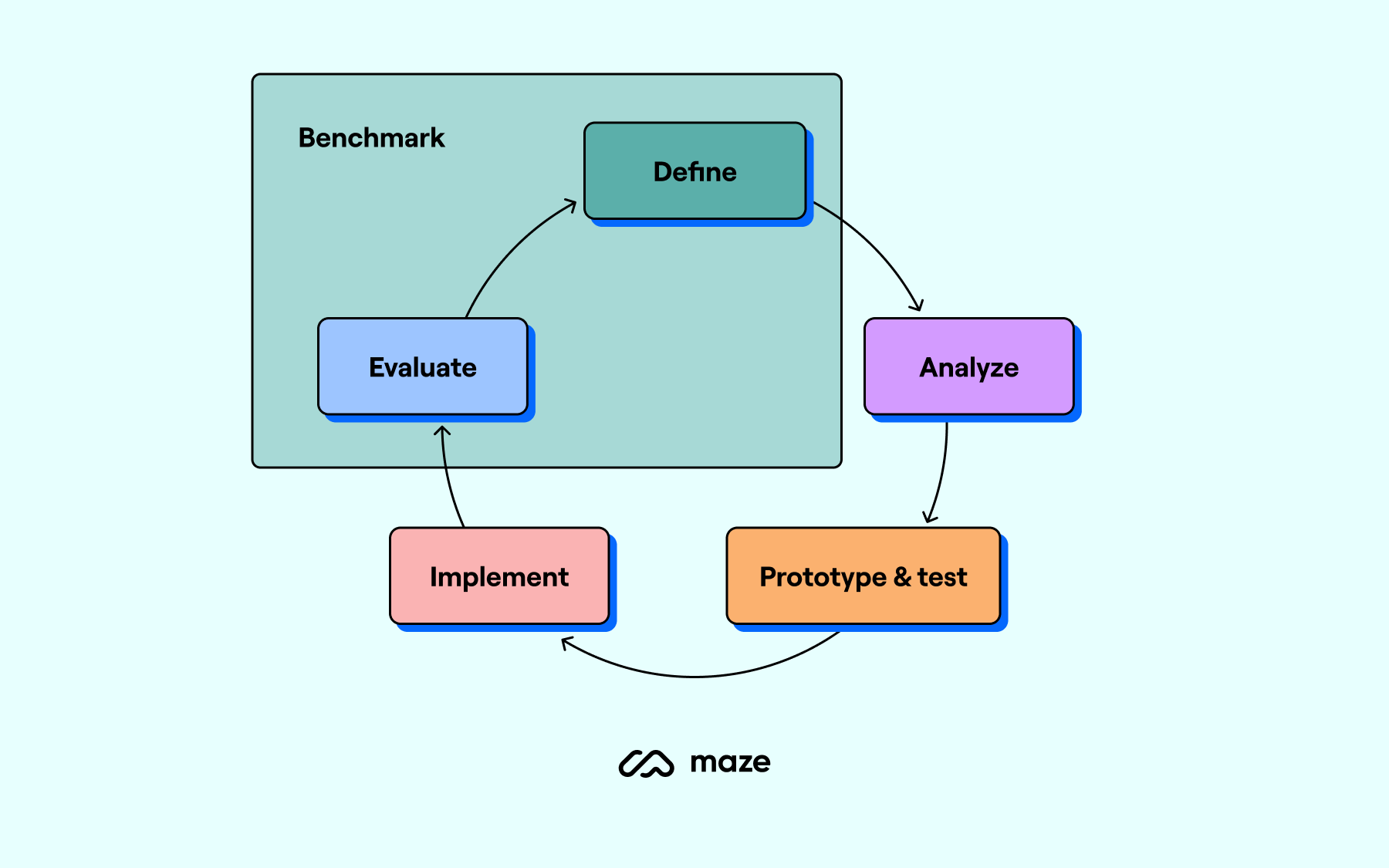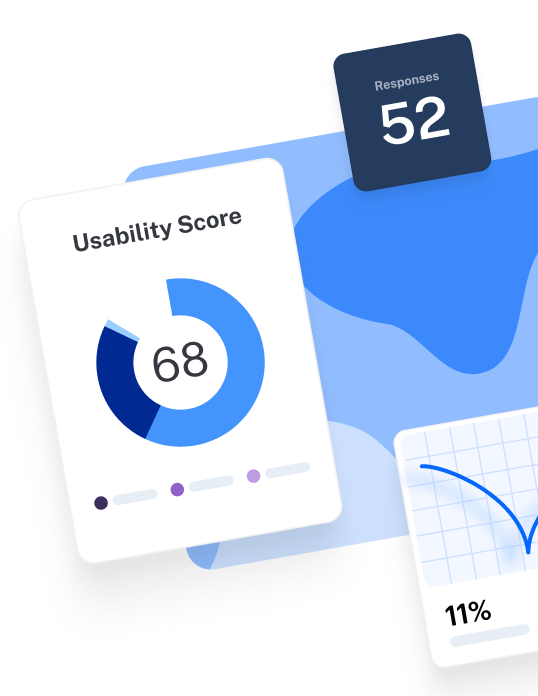TL;DR
UX benchmarking helps you measure your product’s performance using standardized metrics, so you can compare it to past versions, competitors, or industry standards. It’s a powerful tool to track progress, demonstrate UX ROI, and guide product improvements. By consistently benchmarking over time, you gain objective and actionable insights into how your user experience is evolving.
How do you know if your UX metrics reflect success or failure?
An 80% task success rate from usability testing might seem great—until you compare it to last quarter’s 93% score. A customer satisfaction survey of 70% doesn’t seem that impressive—until you realize most of your competitors hang around the 60% mark.
What we’ve just described is the important process of UX benchmarking, which measures your product’s performance and progress, and evaluates your UX. Benchmarking helps you identify where to place your efforts and how to prioritize product improvements.
In this article, we show why, where, when, and how to conduct benchmarking for your UX. You’ll learn the best practices to guarantee success, and the roadblocks to avoid on your path to measuring progress.
What is UX benchmarking and why does it matter?
UX benchmarking is the process of measuring and comparing your product’s user experience against industry standards, your own company’s historical data, or competitors. It pins down your product’s performance by setting it alongside the results of others—ultimately showing you where your UX excels or needs improvement.
The UX benchmarking process is primarily a part of summative evaluation, meaning it helps assess the end result of your design. This is different from formative evaluation, which aims to uncover what works and what doesn't in the early stages of product development.
The biggest benefits of conducting UX benchmarking include:
- Tracking your progress: Monitor how your product’s UX improves across design iterations
- Finding areas of improvement: Compare your product against industry standards or competitors to see where you fall short
- Demonstrating ROI: Benchmarks can be directly tied to long-term business objectives and even convince stakeholders of the value of user research and design
- Improving usability: Benchmarking pinpoints exactly where your product falls short when compared to past product versions, competitors, or industry standards
When to conduct a UX benchmarking study

There are two major phases when it’s best to benchmark:
- Before introducing a product or new feature in the market. Measuring it against competitors or industry standards ensures you both meet and exceed user expectations.
- At the end of a design cycle, right after you’ve implemented a product change and evaluated its effectiveness. If this is your first time analyzing user insights, set them aside to use as historical data later. If not, compare your measurements against results from your previous sprint.
Benchmarking during these key phases will ensure you have a continuous process where you can monitor UX changes and gauge success. You’ll have a clear record of what changes made your design better or worse.
While we recommend UX benchmarking during those two phases, it’s a flexible strategy your team can implement any time you want to check in and monitor progress. It works with MVPs, wireframes, user flows, and low-, mid-, and high-fidelity prototypes.
What types of benchmarking are there in UX?
Benchmarking is all about comparison, and your results will be relative to the standard you’re benchmarking against. The main types of UX benchmarking include:
- Internal: Comparing UX metrics across different products, features, time periods, and teams in your company. For example, you might do internal benchmarking by comparing UX across the mobile and desktop versions of your website.
- External: Comparing your UX metrics to competitors or industry standards, if available. You might do external, competitor benchmarking by measuring your customer satisfaction scores against other companies to understand where your product stands in the market.
- Historical: Comparing your product’s UX measurements to past evaluations and measurements. This method is especially useful to monitor progress across product sprints.
- Functional: Measuring and comparing a specific feature or function across different platforms. For example, you can compare your purchase process across three different SaaS products, noting how much time it takes to complete each task.
- User interface: Comparing your product’s UI for ease-of-use or aesthetic quality to other standards, which can be both internal and external. Use it to measure progress in redesigns or rebrands.
⚙️ Maze tip: Your benchmarking type won’t always fit neatly into these categories. For example, you can conduct a UI benchmarking study and compare measurements to external industry standards. Historical benchmarking is also a type of internal benchmarking. The type of benchmarking you use will depend on your goals.
Where to source benchmark data
Sometimes, benchmarking data will come from the insights you’ve previously gathered through product sprints. Other times, you need to dig up secondary sources for comparison.
Here’s a breakdown of where to get your benchmarking data from:
- Analytics: Platforms and usability testing platforms to track task time, completion rates, and drop-offs
- User testing results: Previous usability test recordings or new sessions using consistent tasks for comparison over time
- Surveys: Data from past rounds, or industry averages for standard metrics like SUS and NPS
- Internal goals or stakeholder input: Product KPIs, team OKRs, roadmap priorities, or expectations from leadership about user satisfaction or performance
- Secondary research: Public reviews, UX case studies, teardown analyses
A 4-step process for UX benchmarking
A successful UX benchmarking study involves planning what you want to measure and how, conducting tests, and then comparing results to internal or external data. Here’s how to start UX benchmarking that actually helps you improve your product’s UX.
✅ Download our free UX benchmarking checklist to ensure you’ve got all your bases covered
1. Define what you want to benchmark
Start by pinpointing a specific area of your product and the UX dimension that you want to benchmark. This can be anything from the navigability of your onboarding flow to the usability of your app’s checkout process.
Don’t know what part of the product experience to focus on? Ask yourself:
- Where are users struggling the most?
- What parts of the product are most critical to success?
- What recent changes need validation?
Setting up your main UX objectives will help you find the type of benchmarking study you need, as well as the right metrics and research methods later on.
2. Identify your benchmarking type and gather information
Next, choose the best benchmarking type for the job.
For example, if your aim is to monitor internal progress, you’ll need to dig up results from:
- Older studies, data, and insights from previous design sprints
- Stakeholder reports that summarize research findings and results
- Revisit your UX research repository if you’ve collected past insights in one place (if you don’t have a repository, we strongly suggest making one for convenient benchmarking)
If you’re planning to benchmark against competitors or industry data, you can find information through:
- Publicly available UX case studies or reports
- Published industry benchmarks (for example, MeasuringU offers a range of SKU, NPS, and UMUX across different industries)
3. Test and analyze data
Before comparing your design against benchmarks to track success, you need to test it with users and analyze the results. You’ll then measure these metrics against the benchmarking sources you’ve chosen.
Settle on the UX research methods you’ll use for testing, and the metrics you’ll measure. For example, prototype testing and quantitative usability testing are both especially useful for monitoring task success, while in-product prompts and surveys are good for gathering CSAT and NPS data.
To make testing easier, consider using UX research tools that help you recruit participants, design, deploy, and automatically analyze the results of your study. For example, Maze’s website usability testing will help you analyze user journeys, while Maze’s mobile testing makes it easy to collect usability metrics from users within your app.
4. Compare your results for insights
Now, we reach the core of benchmarking: comparison. Place your metrics next to industry, competitor, or historical benchmarks for comparison. Depending on the benchmarking type you’ve chosen, ask yourself:
- How does our product perform when compared to our last design sprint? Are we improving, regressing, or stagnating?
- Are we outperforming or lagging behind competitors?
- What are our areas for improvement?
- What feature or function of our product should we improve?
We also recommend turning your findings into reports so stakeholders can quickly make decisions and approve solutions. Reports that contain data visualization with graphs and charts can be especially useful when comparing two metrics side by side.
9 Key UX benchmarking metrics
One of the foundations of UX benchmarking is to work out what to measure and why. Once you have defined the metrics, you can test your product and finally compare it to industry standards, historical data, or competitor performance.
Keep in mind that not all of the following metrics are necessary for successful benchmarking—the metrics you choose to measure will depend on your main goal. For example, behavioral benchmarking is especially helpful for measuring your product’s usability. Attitudinal will be especially useful for understanding how your customer sentiment compares.
Whichever metrics you choose to measure, we recommend being consistent. You’ll likely need to measure them numerous times across product iterations, quarters, and design sprints before meaningful trends emerge.
3 Behavioral benchmarking metrics
Usually measured through usability tests, behavioral metrics capture how users interact with a specific product and feature. Measure them as a part of your benchmarking study when you need to assess your digital product’s overall functionality and ease of use. Behavioral metrics fall into the analytics and user testing methodologies for benchmarking.
Important behavior metrics to help with your usability benchmarking include:
- Task completion rate: Percentage of users who correctly complete a task while interacting with your digital product
- Time on task: How long users take to complete a task
- Error rate: Frequency of mistakes—especially helpful for pinpointing usability issues
3 Attitudinal benchmarking metrics
Attitudinal benchmarks reflect what users think or feel about your user experience. You can include them in UX research methods like feedback surveys, or even include them as in-product prompts for users. Attitudinal benchmarking metrics are especially useful for gauging trust and loyalty and typically require running surveys for benchmarking.
Some examples of attitudinal benchmarks are:
- Net Promoter Score® (NPS): Measures loyalty by asking users what they think of your product
- System usability score (SUS): A standardized survey that provides a perceived usability score
- Customer satisfaction score (CSAT): Often placed after an interaction, this metric gauges how satisfied users are with your digital product
3 Framework benchmarking metrics
What if you want to track behavior and emotion for a more holistic benchmarking study? Framework benchmarks are a great place to start. These standardized models combine both behavioral and attitudinal benchmarks for a complete overview of the user experience. You can get them through a range of benchmarking methods such as analytics, user testing, and surveys.
Some especially useful framework metrics to benchmark include:
- HEART: Stands for happiness, engagement, adoption, retention, and task success. Created by Google, it offers a structured and comprehensive way of measuring UX.
- UMUX Lite: A short, efficient, usability survey where participants rate four items on a 7-point Likert scale, focusing on effectiveness, efficiency, and satisfaction. It’s a concise framework for assessing all-around usability.
- SUPR-Q: A metric measuring usability, trust, appearance, and loyalty across digital experiences. This benchmarking method works by collecting data via a standardized questionnaire and comparing it to other digital products for a percentile score.
Best practices and common pitfalls in UX benchmarking
Benchmarking can be challenging—you’re not just measuring your own product, but often comparing it to an entirely different set of data at the same time. There are many moving parts and roadblocks that can make success more difficult.
We’ve summarized the main dos and don’ts so you can ensure you get reliable insights from benchmarking.
✅ Do's | ❌ Don'ts |
|---|---|
Pilot your benchmark test with internal users first. This helps catch confusing flows or metric setups before launch. | Don’t decide what a “good” result is after seeing the data. That introduces bias and undermines credibility. |
Conduct benchmarking consistently over multiple product sprints. This allows for meaningful trends to emerge. | Don’t drop benchmarking after one or two studies. It can take multiple studies for important trends to emerge. |
Tie back benchmarking results to business objectives. Include the relevance of your results in relation to KPIs like retention or conversion to make your tests more actionable for stakeholders. | Don’t be inconsistent with your chosen metrics. Once you settle on a group of metrics, you’ll need to stick to them throughout studies to validate comparisons. |
Start UX benchmarking with Maze
Benchmarking is like a UX reality check.
It puts your product into perspective, exposes where it can be improved, and shows you where it excels. By comparing your metrics to past studies, competitors, and industry benchmarks, you can decide where to focus your efforts for better usability and UX.
Above all, benchmarking is about continuous learning—it gives you the objective measurements you need to improve your product. A tool like Maze can help by making your benchmarking easier and more reputable. With a suite of comprehensive UX research methods, you can quickly deploy tests and automatically analyze them for comparison.
Frequently asked questions about UX benchmarking
What is UX benchmarking?
What is UX benchmarking?
UX benchmarking is the process of measuring your product's user experience through standardized metrics and then comparing those metrics to historical data, industry standards, or competitor scores. It helps UX researchers pinpoint areas for improvement and track UX progress over time.
How is benchmarking different from usability testing?
How is benchmarking different from usability testing?
Benchmarking is different from usability testing because its main goal is to measure product UX and compare it to other standards for monitoring progress.
Usability testing is a UX research method where participants receive a task to complete using a digital product. Researchers then measure important metrics like task success rate or time on task. There’s still measurement, just no comparison to other standards.
What are the most important UX metrics to benchmark?
What are the most important UX metrics to benchmark?
Some of the most important UX metrics to benchmark include:
- Task success rate
- Time on task
- Error rate
- Net Promoter Score®
- Customer satisfaction score
How often should I run a benchmarking study?
How often should I run a benchmarking study?
Benchmarking should ideally be a continual process that you complete after every design sprint or feature change. Other good time frames include quarterly, after major designs or releases, or annually.
Can I benchmark a prototype, or only live products?
Can I benchmark a prototype, or only live products?
You can both conduct UX benchmarking for live products and prototypes. In fact, benchmarking for prototypes is especially helpful because it helps you monitor progress, reevaluate your UX design process, and facilitate better design decisions before launch.




